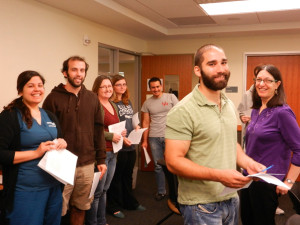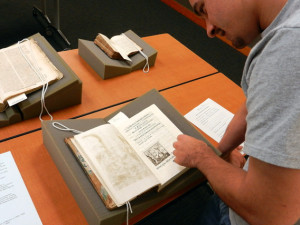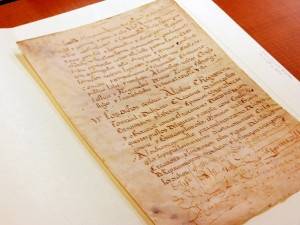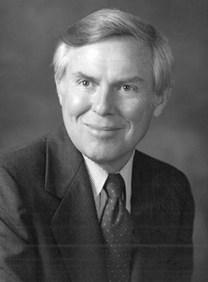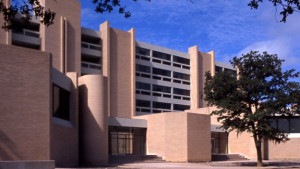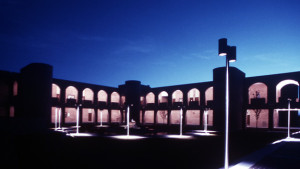
Students from Dr. Susan Kellogg’s course “Researching Mexican History” visited Special Collections this week to learn about conducting research with rare books and archival materials. This course designed for History majors teaches undergraduates to do research using both traditional and digital sources, applying these skills to historical materials related to Mexico.
In the Evans Room, Special Collections’ classroom, students viewed items that dated from the 16th century to the 20th century, such as books, maps, letters, and newspapers. Archival highlights included a letter written by Mexican President Antonio Lopez de Santa Anna in 1833 and a ledger kept by Leonor Villegas de Magnón for her medical organization Cruz Blanca during the Mexican Revolution. All of the archival materials on display were drawn from our Hispanic Collections.
After examining all of the materials, each student selected an item to study more closely, learning to apply the kinds of questions asked by historians to a unique or rare item. Class discussion centered around the intended audience for the work, contextual information that might help historians to interpret items more successfully, and what types of research questions might be prompted by a particular item.
Working directly with rare and archival materials gives students an opportunity to better understand the process by which scholars interpret raw source material to create new knowledge. Faculty members who wish to schedule a class visit to Special Collections can contact Coordinator for Digital Projects and Instruction Julie Grob at jgrob@uh.edu. Special Collections materials are also available to all students for individual study in our Reading Room with the presentation of a photo ID.
 Last month Houston, along with six other Texas cities, were awarded the Scenic City Certification by the Scenic City Certification Program of Scenic Texas. Houston, Kennedale, McKinney, Rockwall, Seabrook, and West University Place, Texas will hold the certification through 2018 indicating that citizens in these cities, “through implementation of strong scenic standards… can enjoy an improved quality of life and businesses find it easier to attract customers and employees.” A reception honoring the cities will take place this evening at the Hilton Austin Hotel in conjunction with the annual conference of the Texas Municipal League.
Last month Houston, along with six other Texas cities, were awarded the Scenic City Certification by the Scenic City Certification Program of Scenic Texas. Houston, Kennedale, McKinney, Rockwall, Seabrook, and West University Place, Texas will hold the certification through 2018 indicating that citizens in these cities, “through implementation of strong scenic standards… can enjoy an improved quality of life and businesses find it easier to attract customers and employees.” A reception honoring the cities will take place this evening at the Hilton Austin Hotel in conjunction with the annual conference of the Texas Municipal League.
Specifically, the Scenic City Certification Program commended Houston for the following:
- Strong standards to enhance the visual character of its streetscapes including sign regulation and landscaping
- Emphasis on establishing and protecting parks, trails and open spaces
- Clearly-stated unity of design standards
- Firm prohibition on the conversion of existing non-electronic billboards to digital format
Here at the University of Houston Special Collections, we preserve and make available for study the records of Scenic Houston, a chapter of Scenic Texas, Inc. Anyone who has driven around Houston over the years will find it no surprise that much of Scenic Houston’s work has centered around efforts to reduce the blight of billboard signage around the city (a fact underscored in the commendation above). Records available for study include a history of much of that work but are not limited to strictly local efforts. As the title of the collection would indicate, the Scenic Houston – Scenic Texas records include primary sources related to other local chapters and state & national chapters as well. Also included are records relevant to the Greater Houston Partnership, the Quality of Life Coalition, and the Scenic Conservation Advisory Council.
As Houston and the other cities receive their recognition this evening, it marks another step forward in a long environmental struggle outlined by other collections in our Houston History Archives. We invite you to reacquaint yourself with Houston’s environmental history in our Reading Room at your earliest convenience.
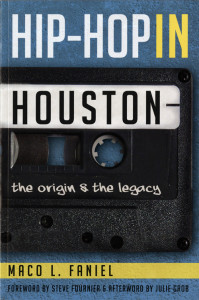
cover of Hip-Hop in Houston, courtesy of History Press
Don’t forget! Mark those calendars! Perhaps tie a string around a finger?
The University of Houston Bookstore presents a book talk and signing for Hip-Hop in Houston: The Origin and Legacy by Maco Faniel (History Press) at 5pm Thursday, October 17th. The event, co-sponsored by the University of Houston Libraries, will be held on the 2nd floor of the M.D. Anderson Library in the Honors Commons. Our own Julie Grob, who penned the afterword for the book and heads our Houston Hip Hop collections, will join Faniel at the talk and signing.
Light refreshments will be available and the event will also feature a small exhibition of memorabilia from DJ Steve Fournier and Carlos “DJ Styles” Garza. Parking is available at the Welcome Center or at the parking garage on Calhoun near Wheeler. We hope to see everyone next week!
The following comes to us from Dr. Stephen James, who took a moment from his work with the Kenneth E. Bentsen Papers to reflect on the recent passing of Bentsen and his legacy.
The University of Houston lost a distinguished alumnus and friend last week. Kenneth E. Bentsen (Class of 1952) was an architect and a gifted designer. He made beautiful buildings that pleased the people who used them. He built a large and important architectural practice that earned the respect of his profession. Today his many buildings shape the environment of Houston and other Texas cities.
We see his work every day. At the University of Houston he designed Agnes Arnold Hall, Philip G. Hoffman Hall, and the Brown wing of M.D. Anderson Library. At the Texas Medical Center, he designed additions for Baylor College of Medicine, renovated the original buildings of the M.D. Anderson Cancer Center, and did most of the new buildings for Texas Children’s Hospital. Even the parking garages benefited from his talent.
Bentsen worked exclusively for large commercial and institutional clients. He designed two high-rise buildings downtown, the Southwest Tower for Bank of the Southwest and the Sheraton Lincoln Building. Both have been demolished. His best-known work in Houston was The Summit, the city sports arena where the Rockets played until Lakewood Church acquired the building. He created buildings in Galveston for UTMB and in Austin for the State Bar of Texas and the University of Texas School of Business. There were many others—too many to list.
Perhaps his most important work of architecture is one that Houstonians rarely see. Bentsen created the master plan and designed many of the buildings for Pan American University in Edinburg, Texas. Now called the University of Texas-Pan American, it is one of the most important educational and cultural institutions in the Rio Grande Valley. Influenced by the Philadelphia master, Louis Kahn, Bentsen established a distinctive regional style for the campus that the university has maintained to this day. Even without his significant body of work in Houston, this project alone would have been a formidable legacy. Very few architects get the chance to design and build a university campus.
Bentsen was born into a prominent family in the Rio Grande Valley, where his father, Lloyd Bentsen, Sr., was a successful rancher and businessman. His brother, Lloyd Bentsen, Jr., had a successful business career in Houston and was for many years a U.S. Senator from Texas. His son, Kenneth Bentsen, Jr., was a U.S. Congressman from Houston. Rather than follow his father and siblings in a business or ranching career, Bentsen pursued his passion for architecture. He often credited his success to his training at the University of Houston and spoke highly of two of his teachers, Donald Barthelme, Sr. and Howard Barnstone, both celebrated Houston architects.
Earlier this year, the University of Houston Libraries acquired all of Bentsen’s professional papers and drawings. This collection, the Kenneth E. Bentsen Architectural Papers, is now being processed and will be housed in the library’s Special Collections Department.
